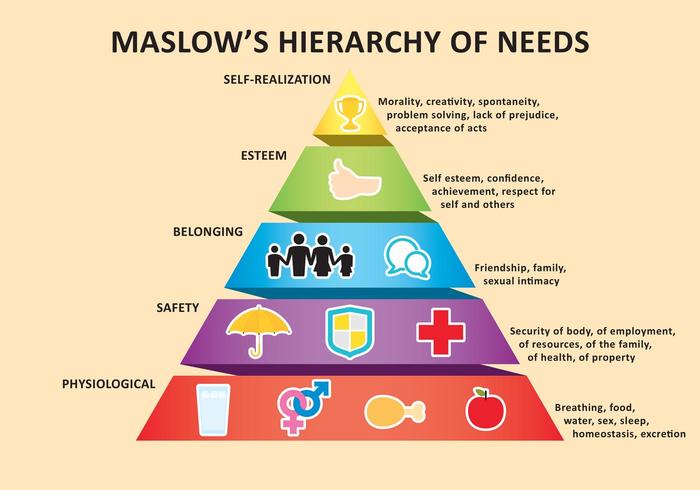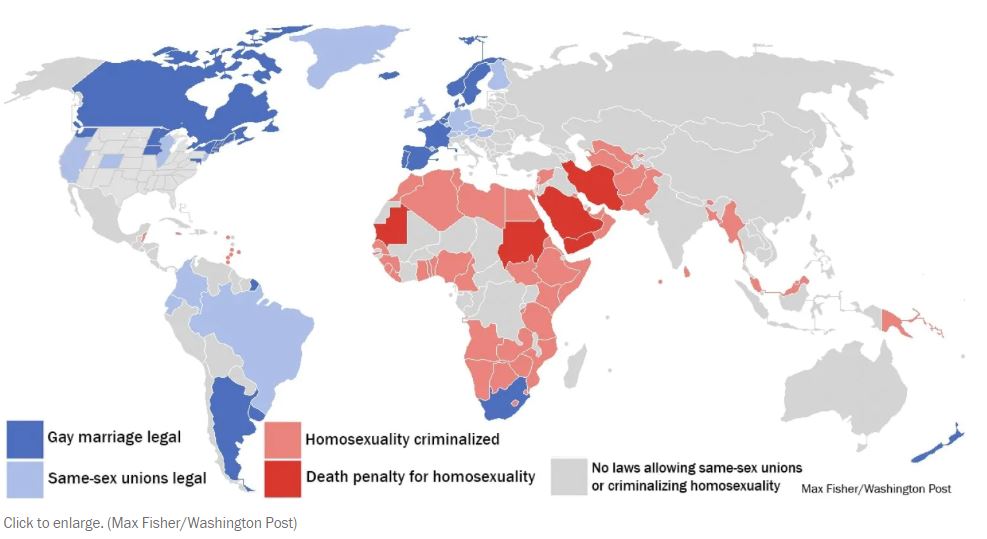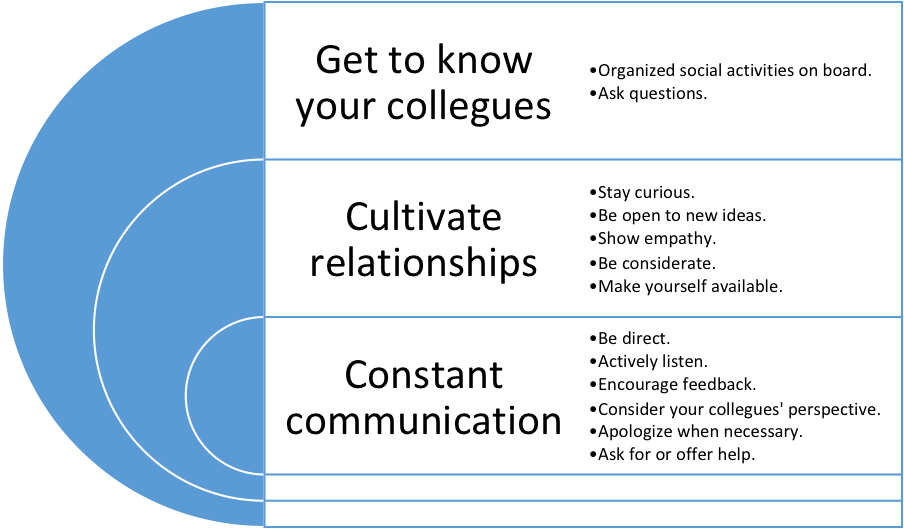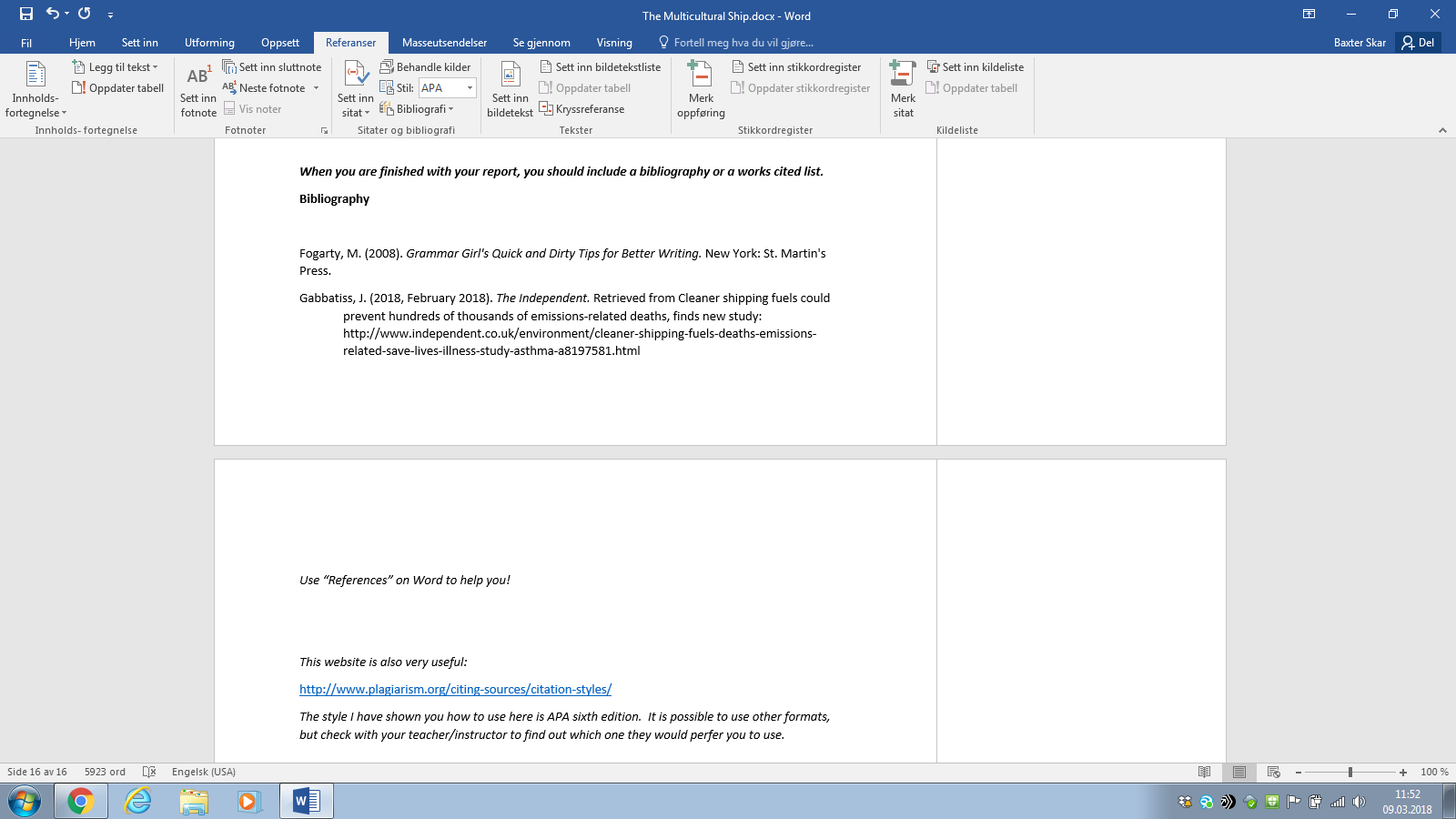Chapter 5: The Multicultural Ship
In this chapter you will ….
- Learn the names and common responsibilities of the different ranks and ratings on board a ship
- Learn what is meant by culture
- Reflect on what culture means to you
- Learn about how culture can affect behaviour and communication
- Discover different methods to help you get along and communicate with people from different cultural backgrounds
- Review the difference between adverbs and adjectives
- Learn how to use and cite sources in your own writing
Working on board a ship for long periods of time, isolated from family, friends, and land, forces a crew to form a society. Oftentimes, this society on board is comprised of people from many different backgrounds. It is necessary that this onboard society cooperate and respect its individual members in order for it to thrive. Respect and understanding between all persons on board is essential for a successful voyage.
Onboard rank
Hierarchy on board commercial vessels is important to ensure “smooth sailing”. Every individual working on a ship must be familiar with his or her responsibilities and aware of the rank and responsibilities of their fellow crewmembers. Without this ranking system, very little would be accomplished on board. While the Coast Guard and other naval vessels have their own, albeit similar, ranking system, the hierarchy on board most vessels is generally internationally recognized. Both non-officer and officer positions may vary slightly within this hierarchy from ship to ship, as well as the duties assigned to them. The title of officer is reserved for those who have received a certification of competence while ratings is the title given to those sailing without certification.
The following chart illustrates a typical hierarchy on board a vessel, along with the most common duties assigned to each position. As previously mentioned, rolls and titles can vary based on the size and purpose of a vessel, and even the qualifications and skills of those working on board. Click on the squares to find out more about the different positions belonging to the deck, engine, and catering departments.
Exercise: Discuss
- What rank and titles have you had while out sailing? What were your responsibilities? How did they change over time?
- How did some of these names and rank responsibilities differ from what you have experienced? Why do you think that is?
CULTURE AND BEHAVIOUR
What do you think of when you hear the term “culture”? How would you answer if someone asked you to describe your cultural background? What does the word “multicultural” mean to you? Believe it or not, how you answer these questions can play a part in how you operate as a crewmember and an officer.
Before we can understand culture and its effect on behaviour, we must first understand the very basic components that drive us as humans. There are numerous theories and schools of thought regarding human nature. One such theory, Maslow’s Hierarchy of Needs, arranges human needs on a pyramid. Maslow theorized that the components that make up the pyramid below are the elements human beings need in order to thrive. Maslow’s Hierarchy is like a ladder: each need must be “climbed” in order to reach the next need, and eventually, the top. Look at the picture below to find out more about Maslow’s Hierarchy of Needs.
Abraham Maslow
Abraham Maslow was an American psychologist whose Hierarchy of Needs was first published in the mid twentieth century. Click here to learn more about Maslow and his work.

Source: Vecteezy.com
Discuss
What have you discovered from the pyramid? What things do we all have in common as humans? Do you agree or disagree with the order of which these needs are placed? Why or why not? How could these play a roll in how people interact with each other?
Culture
Even though as humans we share the most basic biological imperatives, how we satisfy these is often a matter of culture and personal experience. What exactly is culture? The Merriam Webster dictionary offers a variety of definitions for culture, but the one best suited for this discussion is “the customary beliefs, social forms, and material traits of a racial, religious, or social group; also :the characteristic features of everyday existence (such as diversions or a way of life) shared by people in a place or time.” (Merriam-Webster)
Exercise
Take a minute to think about what culture means to you based on the definition you have just read. Write down short answers for the following questions and then compare what you have written with a few of your classmates when you are finished. Alternative: split up into small groups. Each group is responsible for making a chart or graph for three of the questions below based on each student in the class' data.
- What year were you born and where (country and town)?
- What gender do you identify with?
- Are your parents native to the country you grew up in? Describe your family.
- What is your ethnic background?
- Are you religious or do you go to Church?
- What are some holidays or traditions you and your family celebrate or participate in every year? How do you celebrate these?
- What sorts of hobbies did you and your friends have while growing up? Now?
Similarities?
Are there any similarities? All of these things can be considered a part of your culture! They are a part of how you identify yourself and your place in society. Any differences you encountered when talking with your classmates are examples of multiculturalism!

Does your family watch this every year at Christmas time? Source: ndr.de
The questions you answered in the above exercise gives you just a small glimpse of how culture plays a role in our identities. Maybe after you talked about some of your answers with a classmate, you found out that you both watched the same TV show growing up or your families both eat the same thing for Christmas dinner. Of course, culture runs much deeper than just television and family meals- they are the age-old traditions passed down through the years and the collective historical experiences and hardships faced by a society. They are part of an identity you share with many others. Your cultural experiences make you feel accepted and safe. However, they are not something you are born with. Much of your cultural background is based on how you were brought up. Your family, school, and social circle have all played a part in how you became the person you are today.
Exercise
Take a minute to write down a few of the people who have had the most influence in your life. Consider how their involvement has shaped who you are today. Why and how have these particular individuals influenced you? What effect have they had on you? This can be from your value system to how you act in social situations.
Culture and Behavior
Your cultural background impacts many aspects of your daily life- from your work ethic to your interactions with others. Culture acts as a filter. It modifies your behavior and your perceptions. However, it is important to remember that culture only influences behavior. It is not an absolute, and it does not determine how a person will act or react in every situation. In a report discussing the interactions of Filipinos and Danes while on board Danish vessels, Fabienne Knudsen, whose research focuses on multicultural crews, explains how culture is just one of many things that affects our behavior.
Sometimes you get the impression that culture is a "thing" engraved in the brain of man which dictates norms, values and behaviour. If that were the case, you could calculate how for instance a Dane and a Filipino would act in a certain situation. The trouble is that two situations are never the same and even though they were, two Danes/Filipinos would hardly act in exactly the same way. One individual would probably not even act as he did 10 years earlier, maybe because our culture is in constant motion. Our cultural background even offers several possibilities of action, and few would act in the same way if they, for instance, were seated in front of their boss -- or their children. Cultural behaviour cannot be under-stood independently of the isolated situation and of the conditions in which an event takes place.
Further, culture, especially the national culture, may only explain part of our behaviour. A Dane is neither completely like all other Danes nor is he completely unlike other people. On the one hand, his unique experiences and life story make him a human being unlike anybody else; on the other hand, he has wishes and needs which he shares with everyone else, for instance the wish to be respected, to have a meaningful job and for his family to have a certain standard of living, etc. In-between he may relate to many overlapping communities. (Knudsen, 2004)
While your cultural background may not have the final word in how you communicate and interact with others, it does have notable influence. Culture's effect on behavior is of extreme interest to corporations and companies with a multicultural staff; so much so, that companies are willing to fund research in order to find out just how much culture shapes the way people behave. The following is from a study conducted in 2006 that compared the brain activity of East Asians and Westerners.
The difference noted between older people in the two cultures can be explained in part by earlier research that suggests East Asian culture is less individual-oriented than Western culture, Park says.
"East Asian cultures are more interdependent and individuals spend more time monitoring the environment and others," Park says. "Westerners focus on individuals and central objects because these cultures tend to be independent and focused more on self than others."
Scientists have known since the early 1970s that Westerners and East Asians respond differently to visual stimuli. But until recently, research on the subject lacked data on what neurological differences---if any---existed between the two cultures.
Last year, Park's group published a report suggesting that activity levels in certain parts of the brain are different in Americans than in East Asians when they process visual stimuli. In Americans, regions of the brain involved in object processing were more active; in East Asians, areas engaged in processing background information were more active.
This new study, published in the May issue of Cognitive, Affective & Behavioral Neuroscience, builds on the earlier work, offering further evidence of a neural component to this behavioral theory. The findings add weight to the argument that culture impacts individuals on a biological level, Park says. (Burton, 2007)
The study you read about above is just one of many that is interested in discovering how culture influences behavior. The research focused on Westerners (including, but not entirely limited to North America and Western Europe) and East Asians (including nations like China and Japan), and later in this chapter, you will read about some of the differences between these two cultures.
Multinationalism. As you learned earlier, your culture is based on many factors: gender, age, economic background, ethnicity, etc. The country you were born and/or grew up in also has major influence on your cultural identity. A multicultural workplace, like on board a ship, employs people from a variety of cultures and nations. Many shipping companies are multinational workplaces, meaning they employ individuals from many different countries. It is fairly obvious that people from different countries have different cultural backgrounds, and this type of working environment has both its advantages and disadvantages.
Say hello
How do you say hello to people? Watch the following video to see how people from around the world greet each other!
Working with people from different countries can be challenging. Later, this chapter will examine some of the problems that can arise when people from different countries communicate and what can be done to aid cross-cultural communication.
Stereotypes. Generalizations and assumptions about an entire ethnic group, religion, race, gender, or any group of people is stereotyping. Sometimes these concepts can be humorous and inoffensive, for instance, all Norwegians love skiing and blue and white knitted sweaters. Other stereotypes can be hurtful; like all Jews are greedy or Irish people are alcoholics. Stereotypes that offend or focus on negative aspects of a culture are often considered racist, and these kinds of statements can be toxic when attempting to communicate with individuals from a different cultural background than yourself.
Throughout history, stereotypes have been used to encourage discrimination against different groups of people. By using stereotypes, Hitler was able to convince people that Jews should be eradicated, singling them out solely because of their religious beliefs and culture. There are many other historical examples where stereotyping has been used to incite fear and hate in a society thus causing them to react negatively to a particular group of people.
The Holocaust Museum
Click here to visit the US Holocaust Museum's website to see how images and pictures were used by the Nazis to spread racism and anti-Semitism.
It is important to be aware that assuming a person is a certain way because of your beliefs about their culture could cause the other person to become offended or even hurt. Sometimes, it can be difficult to know what is acceptable to say or do in the presence of someone who comes from a different culture or country. Mistakes are going to happen, and when they do, it is important to apologize and have an open and honest dialogue with the person or people who were hurt. Later in this chapter, you are going to find out how miscommunication happens and what steps you can take to avoid it.
Exercise
Make a table in Word or by hand, writing down any stereotypes you are familiar with about the following cultures:
- Norwegians
- Americans
- Filipinos
- Russians
- Swedes
- Polish people
- Africans
- Middle Easterners
Decide if the stereotypes you have written down could be considered offensive or hurtful to someone from the particular culture they are about. Why or why not? How did you come to know of this stereotype- through personal experience or because of something you heard?
Privilege. Advantages and benefits that are the result of one's race, nationality, gender, sexuality, and even one's cultural background are commonly referred to as privileges. Privileges range from access to free education and healthcare because of where you were born to not being afraid for your safety when going into public because of your race or sexuality. What privileges a person has had throughout their life often have a major impact on what they are able to accomplish as adults.
Most of the time, privilege is something that is beyond a person's control. When you work with people from different backgrounds, you never know what privileges they may or may not have had. Being aware of what privileges you have had in your life can help you empathize and better understand the thoughts and actions of others. Click on the link below to watch a video illustrating how privilege can affect a person's ability to achieve success.
Teacher tip: Exercise. Have all the students sit in rows/at their desks. Place a bin in the front of the classroom and ask all the students to take out a piece of paper and form a ball. Students should then try to throw their paper balls into the bin without getting up. Ask them if they thought it was fair that those in the front were closer to the bin and therefore had a better chance of getting their paper ball into the bin. Discuss how this exercise demonstrates the advantages of being closer to one's goal (privilege) affects one's chance of "making it". Have the students reflect over what privileges they may or may not have had throughout their lives.
COMMUNICATION
One of the most important tools you will have to use while working at sea is communication. As a future officer, you will have a great deal of responsibility on board. Not only will you have your own tasks to accomplish daily, but you will likely have to delegate responsibilities and duties to other crewmembers as well. Besides that, working at sea is no simple task. Many stressful factors can come into play when working on board a ship. All of these elements will influence your ability to communicate properly and successfully. Both environmental factors and personal factors can affect how people communicate. Below, you see a table with a list of these different factors. Can you think of more?
FACTORS THAT AFFECT ONBOARD COMMUNICATION
| PERSONAL FACTORS | ENVIRONMENTAL FACTORS |
|---|---|
| – Fatigue | – Weather and temperature |
| – Homesickness | – Deadlines |
| – Disabilities | – Poor working conditions |
| – Illness | – Bullying |
| – Family problems | – Disagreements with colleagues |
| – Loneliness | – Poor leadership |
| – Stress | – Workload |
With such a multitude of factors involved in communication on board a ship, it’s no surprise that problems occur. There is no such thing as an easy fix when attempting to improve onboard communication. There are, however, a number of ways that can help when trying to communicate with your colleagues:
- Working language: A working language must be established and enforced on board. In most cases, this language should be English. Having one language that all crewmembers must use to communicate, even in social scenarios, helps to ensure safety and fosters a sense of community. A good team has to be able to understand each other.
- Clear and direct: When giving instructions and messages of importance, be direct and clear. Say exactly what you mean. When relaying information of importance, it might even be a good idea to have the person you are speaking to repeat what you have told them. Putting things in writing can also help when communicating with large groups of different backgrounds.
- Actively listen: When someone tells you something, listen to what they are saying. This might seem obvious, but often times when we are engaged in conversation, we begin to think of how we are going to respond while the other person is still talking. Active listening requires you to focus on what the person who is talking is saying. Afterwards, you can follow up with questions about things they have said, as well as your own comments on the matter.
- Be patient and understanding: As you noticed from the list of factors above, so many things can influence communication. Perhaps the person you are talking to is experiencing stress because of an illness or a family situation. This can absolutely affect their ability to communicate objectively. Keep in mind that everyone you are working with has their own factors at play, and your empathy is necessary to both giving and receiving information.
Empathy
Empathy is attempting to understand and identify someone else's situation, feelings, and intentions. Have you ever heard the song "Walk a Mile in My Shoes" by Elvis Presley? It is based on an old saying that suggests you should try to see things from someone else's perspective in order to understand their actions. Empathy is key in being a good colleague and leader, and being able to see things from another's point of view is necessary for good onboard communication. Eminem's song "Beautiful" also deals with how someone's life and background should be considered before judging them for their actions.
Exercise
Go to TedEd's website to watch the video "How miscommunication happens (and how to avoid it)". After watching the video, click on the "Think", "Dig Deeper", and "Discuss" options to work with the ideas presented to you in the video.
Exercise
Get into pairs. Each pair should have one pencil or pen and one piece of paper. Both of you should be holding the pen or pencil. Now try to draw a house on your paper without talking.
What happened? How can communication help you draw this house together?
CROSS-CULTURAL COMMUNICATION
We become aware of other peoples‘ culture when we come to understand that we should look objectively at what is going on around us, and reshape our perception in such a way so as to be able to accept what at first we reject, i.e cultural shock; we should admit, or tolerate the others‘ behavior, thoughts, customs, and values. Cultural competence should be understood as a process achieved in time. Therefore, we consider it imperative to give our students an understanding of different cultures. Members of diverse cultures living and working together may not always agree, may become confused in problem solving, since they possibly have different ways of dealing with them. However, different approaches can be very valuable and beneficial when people have learnt to fit in. (Ion, 2014)
Introductory exercise
Using the table in this document (Working with other cultures.docx), write down a list of some of the other nationalities you have worked with. Did you encounter any challenges when working with people from other countries? What were they? What were some advantages and disadvantages? If you have not worked with anyone from another country, you may write down what you think might be the advantages and disadvantages of working on a multicultural crew. Discuss your answers with a classmate.
Some of the biggest problems that occur in multicultural and multinational workplaces stem from miscommunication. Sometimes a low level of English competency can be blamed for failed communication- something the STCW and other international organizations are trying to fix with regulations requiring seafarers to be able to communicate in English.
Other communication problems that can occur are more subtle and harder to identify. In order to establish successful communication, one must first understand the individual with whom you are trying to communicate.
As mentioned earlier, culture's influence on behaviour is of particular interest to companies employing people from different backgrounds and nations because it is necessary for every employee to effectively communicate with one another in order for the company to function and be successful. A good deal of research has been done analysing the communication styles and comparing the behaviour of different cultures and nationalities, and the following focuses on a few aspects that you as a future officer are more than likely to encounter if you work with a multicultural crew.
Not what you say, but how you say it: High and low context cultures
People are individuals, and their actions and responses in situations are not confined to the constructs of their nationality or cultural background. Despite this, people often operate in a manner common for their culture. Learning how different cultures communicate can help when attempting to communicate with others in work related scenarios. Anthropologist Edward T. Hall suggested in his book Beyond Culture that the way different nationalities and cultures perceive, behave, and communicate can be categorized into high and low context. While the chart below divides cultures into two categories based partially on high and low context culture theory, it is important to remember that most individuals behave in shades of grey rather than black and white. You might find yourself identifying with both high and low context attributes, and that is more the norm than adhering strictly to one category or the other. Examine the chart below to learn more about high and low context cultures.
| Attributes | High Context | Low Context |
|---|---|---|
| Relationships and personal identity | – Relationships require trust and take time to develop. – Greater difference between close friends and acquaintances. – Strong relationships are necessary in reaching goals. – Family, culture, and work all play an important role in identity. |
– Relationships can begin and end quickly. – Not a big difference between close friends and acquaintances. – Rules and procedures are important in reaching goals. – Personal accomplishments and sense of self play an important role in identity. |
| Authority | – More focus on rank and hierarchy. – Clear leader who is in charge and shoulders most of the responsibility. This leader typically works for the good of the group. – Open and honest dialogue can be difficult between those in leadership positions and their subordinates. |
– Less focus on rank and hierarchy. – Shared responsibilities in work situations. Leadership rolls are not always specifically defined. – Rank and hierarchy have little implication on communication. |
| Behaviour and Communication | – Very expressive when communicating; facial expressions, voice tone, gestures, and eye movement are just as important in communication as the words used. – Situation and context elements (environment and people involved) are just as important the words used. – Indirect speech– context clues must be used to interpret the overall message. – Conflicts and disagreements are taken personally and tend to be avoided. If unavoidable, they can have a negative effect on both the relationship and the task at hand. – Personal space is not that important. – Thinks holistically and takes into account many elements when solving problems and communicating. |
– Facial expressions, voice tone, gestures, and eye movement have less meaning in regards to the words being said. – Direct speech that relies little on context clues and environmental elements and mainly on words. – Disagreements can occur and are seen as a healthy and necessary part of communication. Conflicts are typically not taken personally. |
| Concept of time | – Polychronic* – Looser concept of time; what needs to be accomplished is more important than when it actually gets accomplished. – Change happens gradually. – Time is a process. |
– Monochronic* – Scheduling and sticking to plans are important. When the task is accomplished is just as important as accomplishing it. – Change happens quickly. – Time is a commodity and must be used efficiently. |
| Collectivism/ Individualism | - Community and society as a whole are valued over the individual. – Fitting in is important. |
– One's needs are more important that of the society or community as a whole. – Being an individual is important. |
*Find out about the difference between polychromic and monochronic time by watching this video from Tero Trainers who specialize in international business communication.
Examples of countries on the high and low context spectrum

Erin Meyer
Erin Meyer is an American author and professor who specializes in international business relations. She has written books and often conducts seminars about cross-cultural communication. Click on this link to find out your cultural profile: Erin Meyer: What is your cultural profile?
Now that you know a little about high and low context cultures, you might be wondering exactly how this information will help you in communicating with people from a culture different from your own. Having a basic understanding of where the person you are communicating with is coming from, i.e. their culture and nationality, can help you interpret the information you receive from them, both verbal and non-verbal. Look at the following exercise presenting different scenarios involving people from both high and low context cultures. How would an understanding their culture help you in these situations?
Exercise
In pairs or groups, discuss the following scenarios. Are they examples of high context or low context cultures? How would you respond in these situations?
- The Captain has called a meeting for 10:00. Most of the crew show up at 10:20. The Captain becomes irritated.
- After the Captain has finished speaking during a meeting, he asks if anyone has any questions. No one moves or says a word, but he notices two crewmembers who wish to comment because of the way they are looking at him.
- Two engineers have a heated disagreement about how to make a repair. After finally agreeing, they carry on with their work. One of the engineers is unaffected by the conflict while the other feels hurt by his colleague's harsh tone during the disagreement.
- The Chief Engineer has been explaining a maintenance procedure in detail to a new engineer who is quite a few years older. The new engineer becomes offended because he thinks the Chief Engineer assumes he cannot do his job.
- A new deck cadet has joined a crew, and she is eager to learn. However, she refuses to ask questions because she does not want to annoy her superiors.
Tell a Tale
Chief Engineer Torbjørn Johansen, who lives and works in Rovær, has nearly four decades of sailing under his belt; two of which have been spent on board commercial vessels. As a 16 year old in Lofoten, he started off as a fisherman before finally realizing he wanted to sail the seas on board bigger ships. It did not take long before he was finally able to fulfill his dream, and at last count, he says he has visited nearly 70 countries.
A chat with the chief
"On one of the cruise vessels I sailed on, there was a crew made up of 52 nations on board!” After 20 years of working and living abroad, he has learned a lot about communication and working with people from different cultural backgrounds. “The biggest cultural differences are, of course, the language, but also how things are done.” He says that different cultures have different working habits. “As a Norwegian, I like, speaking for myself, to get things done and try to do it right the first time. Some crew do not always have too much pride in their work. Some do not tell you everything, especially when things go wrong!”
Working with different cultures is not always a negative thing. Torbjørn says that with so many different cultures working together, you have access to greater knowledge. “All together you could have good knowledge of a great many things. Always use all the resources around you.”
Language issues can be a major disadvantage- “If you do not fully understand one another, it is easy for mistakes to happen.” Torbjørn says there is a solution for language related mistakes. “It’s very simple. You simply can’t work with an international crew without speaking English. The working language on ships is English, even on many Norwegian flagged ships. All instructions are in English as well as all reports you have to write, even communication with the authorities and so on.”
However, language is not the hardest thing to overcome when working with a multicultural crew. The biggest challenge? Getting the crew to trust you. “Be humble, respectful and listen to them! Do NOT go to sea with an attitude that you are Norwegian and therefore the best. If so, you will lose. There are a lot of good sailors out there. Learn from them.”
When asked what advice he has for future officers, Torbjørn replied, “You are on your way to becoming an officer. Start behaving like one. Be respectful to everyone. Treat all the way you like them to treat you. It’s not easy to handle all the problems with the crew, but you get a long way with a smile and by listening to them. Yelling and screaming gets you nowhere. You will only make more problems for yourself. Work hard with them, and they will respect you!”
Exercise
*Watch this TEDTalk with Pellegrino Ricardi, an expert on cross-cultural communication, and answer the questions below. You can read more about Pellegrino on his website. Answer these questions while watching the video. *
Gender and Sexuality. While the ability to communicate with people from other cultures is very important for a crew’s functionality, it is not always differing nationalities that present a problem. A crew member’s gender often affects not only their role on board, but also how they are treated by other crew members. Historically, the majority of those who work at sea are men, and the women who have been able to cross this gender barrier, have remained invisible. Many Western countries, including Scandinavian countries, have striven for equality between genders for years. In Norway, a law guaranteeing equal treatment for both men and women was passed in 1978. This law was created to ensure that women and men should be paid the same, and they should be offered the same opportunities. Despite this, quite a few workplaces struggle to establish fair and equal treatment for employees of all genders.
Traditional viewpoints regarding gender roles held by crew members on board vessels staffed with a crew of various genders can be problematic. If men and women are to work together, a mutual trust and respect needs to be established. This can be difficult when you throw multiple nationalities into the mix. Unfortunately, not all countries believe in gender equality. When people from countries that feel women should answer to men are forced to work side by side with women, or even under women in leadership positions, conflicts can occur.
Below, read what Linda-Merethe Pedersen has to say about being a female officer on board a vessel.
From working in the kitchen on board a ferry to a position as a first officer and safety officer on board an anchor handling vessel, Linda Pedersen's experience has taught her a great deal about working with people in a maritime setting. Linda has worked on a variety of vessels: a ferry, a platform supply vessel, a multipurpose vessel, and an anchor handling vessel. She has also worked as a technical safety engineer for Aibel where she checked that projects had enough safety appliances and made sure that technical details were in accordance with regulations. While her job as an engineer was enjoyable in many ways, Linda says, "To be out on a ship sailing, that's for me."
She was 16 years old when she first started working on board a ferry making food. Linda's mother worked in the cafeteria on the ferry, making it a workplace with which she was very familiar. Linda's initial field of study was to be economics, but after realizing she lacked interest in the subject, she returned to the ferry. She remembers the crew saying, "Why don't you become a captain? If we can do it, you can do it." After some consideration, she thought, "Why not?"
She then applied for school in Ålesund, where she finished all three years of the necessary education consecutively. She was one of two women taking nautical studies in Ålesund. Linda's goal after finishing her education was to work for Hurtigruten, but at the time, everything maritime related was focused on the oil industry. After writing her thesis about Farstad Shipping, the company offered her a cadet position, which she took.
Overall, Linda feels she has not faced too many challenges as a woman in a male dominated career. Starting out, she remembers that the older sailors did not to like having a female on their ship. "They don't like to have a female on the bridge telling them what to do." She says that some feel women are unable to do heavy lifting, and that women are not strong enough to do many of the physically demanding jobs that come with working on board a boat.
She recalls the need for physical strength on board the anchor handling vessel where she was a first officer. A lot of the work on board an anchor handling vessel is hard and many duties require strong crew members. Linda says, "You should be strong enough, and if not, you had nothing to do there." Even though Linda participated in many physically demanding jobs on board, she was able to "trade" some of the specific activities involved with anchor handling with other crew members. While other crew members took on the physical labour, Linda helped out by assisting in filling out these crew members' timesheets on the computer. "As long as I could give them something, they helped me with doing the physical."
Linda says that her approach has been to be humble, share experiences, ask people about their personal lives, and listen. She feels this has been successful when it comes to getting people to talk to her and teach her new things. "As long as you want to talk, it's easier." This is something she says works for both males and females. "Ships in the offshore business, I think there's a lot of men there which have a family; they have kids. We are all in the same position, more or less. We are not so different."
While many of the ships Linda has previously sailed on have employed a mostly Norwegian crew, the multipurpose vessel she worked on was multicultural. "There were people from the Philippines, from Poland, from Spain, from Italy. There were people from all over the place." She continues by saying, "If you said 'hi' to people, and you were nice, and you tried to talk with them a little bit, and you tried to treat them with respect, everything was fine." It is important to try to see people and talk to them- "If you do that, you'll come a long way. It's easy."
"I have been lucky." Linda feels she has not encountered too many gender related challenges during her time at sea. Much of this is due to her dedication to her work and her ability to focus on her tasks on board. This has garnered her respect from her colleagues. Another benefit she has had was sailing under captains who do not tolerate sexist behavior from their crew. However, Linda says it is important to have a thick skin and not take small offences personally.
Linda remembers two Italians that once came on board a vessel where she was working. "A woman on the bridge! How can that be? So, I talked to them, and they asked me what my duties were and why I was doing this..." She explained to them her fascination with sailing and that working on a ship is a nice job. "As long as I talked to them and got to know them, there wasn't any problems." Linda feels that women working alongside men from cultures that still support traditional gender rolls helps break down these barriers. She says that when these men see her doing her job, that "their opinions and traditional ways" become less influential in the workplace.
Women may feel they have more to prove when coming on board a vessel for the first time. For Linda, this was about showing the other crew members that she could do the job she was hired to do. Linda feels that problems more commonly arise between genders if women on board are given special treatment. "As long as you can show them you can do the same job. If you are given advantages just because you are woman, like that maybe you should not wash in the fresh water tank," then problems can occur. Male crew members will not respect their female colleagues for getting easier tasks. However, this has never been a problem for Linda who says, "I did everything... I was looked upon as one of the guys. That was what I wanted." Linda emphasizes the importance of professionalism when working at sea. Gender related conflicts can be avoided if everyone involved does their job and treats each other with respect.
When asked if she has any advice for people considering a career at sea, Linda offered a few tips:
- Keep it professional and focus on the job.
- Enjoy working with different kinds of people.
- Be open, but not too open.
- Stay motivated in the midst of challenges.
- Develop a thick skin.
- Be polite.
For women considering becoming sailors, Linda says, "Go for it. It's nothing to be afraid of. Men and women are not that different. We are pretty much the same. But be prepared. Some people might not want to have you on board because you are a female, but focus on doing your job and maybe things could change. They might come to respect you and want to have you on board."
Similarly, another group of people who are often affected by traditional ideas while working at sea are those from the lesbian, gay, bisexual, transsexual, and intersexual (LGBT+) community. Again, Scandinavia has been among the first of the Westernized world to establish that all people, regardless of race, gender or sexual orientation, deserve equal treatment and rights. Though this tends to be a common belief for many people in the Western world, quite a few countries still enforce strict laws regulating the sexuality of their citizens. The map below shows which countries still impose laws prohibiting, even punishing, those in the LGBT+ community. Understandably, when people who believe that being LGBT+ is wrong are forced to work with LGBT+ people, clashes may occur. This can be detrimental to communication and efficiency on board. In delicate situations such as these, both parties must be approached and a solution must be reached in order to restore peace among the crew.

Figure 2 Read the article Here are the 10 countries where homosexuality may be punished by death from the Washington Post
The Human Rights at Sea is a charitable organization that advocates for LGBT+ individuals in the maritime community through research and outreach. Visit their website to read about their work and about LGBT+ mariners.
Human Rights at Sea: LGBT+ at Sea
Better cross cultural communication. There is no rule book or standard procedure when attempting to improve communication between cultures. It's a process that takes time and careful thought. You might have some ideas of your own in regards to improving communication. The following diagram presents a few suggestions. Can you think of any more?

What are some ways you as an officer could implement the aforementioned tips? Make a table where you give a practical example or two for each one.
Perhaps growing up you were told to "treat others the way you want to be treated." This simple saying is the bottom line when working and communicating not only with people from other cultures, but with all people you interact with on a daily basis. However, if you really want to create an open and effective workplace environment, the rule you should follow is "treat others the way they want to be treated." This principle requires you to find out about the people around you and really get to know and understand them. By asking questions and being genuinely curious when getting to know your collegues, you will discover, in time, that you have built relationships rooted in trust and mutual understanding . If you treat others with respect, and you are open and honest about your intentions, then communication will more often than not, be successful.
Academic writing: source reference
Most of the time, you will be asked to create texts and write reports in your own words. Your own ideas should be the foundation of any texts you write. This does not mean, however, that you cannot use the work of others in your writing. Quoting and referencing outside material can further your arguments and give depth to the concepts you are discussing. If you decide to reference someone else's writing, you must do it properly. Failure to document the sources you use is plagiarism.
So what is the correct way to document your sources?
Let's say you're writing about the future of fuels in the shipping industry. You have gone online and found an article with information you wish to use in your report:
You especially like this quote, and you decide to use it in your text:
"Cleaner, low-sulphur fuels for ships could reduce the number of deaths linked with air pollution by around a third, according to new analysis. Such fuels also have the capacity to halve the number of ship pollution-related childhood asthma cases." (Gabbatiss, 2018)
You can now use the quote in your work in one of two ways:
- You can include this quote in your report using the same format that is used above, but with some kind of introductory statement.
Example: Cleaner fuels are necessary to reduce emissions from the shipping industry which are responsible for a great deal of health problems.
- You can re-write the quoted sentences in your own words, but you still have to give credit to the original source.
Example: The Independent recently published an article disucssing the problems caused by emssions from the shipping industry. Ship pollution can be blamed for causing asthma in children, and even death. (Gabbatiss, 2018)
As you can see in the examples above, the information used from the article is followed by the author's name and the year of publication in parentheses. This particular informaiton was taken from a website, and how you indicate your source within your work will vary based on the kind of source you use.
If the quote you wish to use is longer than forty words, you use a format called block quotation.
Block quotations are made by "tabbing" in twice and changing the line spacing to 1.
However, the researchers who conducted the study, led by Dr James Corbett of the University of Delaware, said low-sulphur fuels were far from a fix-all solution. "Despite these reductions, low-sulphur marine fuels will still account for around 250,000 deaths and around 6.4 million childhood asthma cases annually, and more stringent standards beyond 2020 may provide additional health benefits," they wrote. To make a significant impact on air pollution from shipping, some experts say there is a need to move beyond fossil fuels in the sector altogether. "This is a sector with huge potential and growing commercial appetite to move to become zero-emitting both of pollutants and greenhouse gases," Dr Tristan Smith, a shipping researcher at University College London, told The Independent. (Gabbatiss, 2018)
When you are finished with your report, you should include a bibliography or a works cited list.
Bibliography
-
Fogarty, M. (2008). Grammar Girl\'s Quick and Dirty Tips for Better Writing. New York: St. Martin\'s Press.
-
Gabbatiss, J. (2018, February 6). Cleaner shipping fuels could prevent hundreds of thousands of emissions-related deaths, finds new study. Retrieved from The Independent: http://www.independent.co.uk/environment/cleaner-shipping-fuels-deaths-emissions-related-save-lives-illness-study-asthma-a8197581.html
When creating your bibliography or works cited list, you will need to use a specific format like what you see in the bibliography written above. The style used here is APA sixth edition. It is possible to use other formats, but check with your instructor to find out which one they would perfer you to use.
Your bibliography should always be in alphabetical order based on the last names of the authors of your sources. Below, you can see how you should write bibliography entries for a book and a web article.
Book
Author last name, Author first initial. (Year of publication). Book title written in italics. Place of publication: Name of publisher.
Web article
Author last name, Author first initial. (Year of publication, Month and day). Name of the article in italics. Retrieved from Name of website: URL.
Sometimes it can be difficult to find all of the information you are asked to include in your bibliography. For websites, you can often find publication information at the very bottom of the site. For books, publication information is typically found somewhere in the first three pages of the book. The information will look something like this:

Word processing programs
There are many different kinds of writing programs that can be used today, but the one most commonly used is Microsoft Office's Word. This particular program offers a feature that creates citations and bibliographies for you.

After opening the "Referanser"/References tab, you can chose to do three things:
- Click "Sett inn sitat" to create a new source in your bibliography list and to have Word add the appropriate in text citation after you have quoted or used information from that source.
- Click "Behandle kilder" to edit, add, or delete sources from your list.
- Click "Bibliografi" to add your source list to the end of your text.
As you can see in the image above, you can change the style of your bibliography by clicking where it says "Stil: APA".
Visit "Kildekompasset" to find out how you document different kinds of sources both within your work and in your bibliography.
Language learning
ADJECTIVES AND ADVERBS
Watch this video of engine startup routines and write down a few words describing the things you see and here.
If you watched the video above, you might have used words like loud, noisy, droning, systematic, or familiar. The words you used to describe what you saw are adjectives and adverbs. You are more than likely familiar with adjectives and adverbs even if you are struggling to remember what the two terms mean. Both words are used to describe, but they describe different things. Simply put, adjectives tell you what while adverbs tell you how. Look at the following description of a engine room fire:
The catastrophic damage to Anchorcat 8’s port main engine was caused by the failure of a piston connecting rod big end shell bearing. This unfortunately resulted in the connecting rod assembly releasing and penetrating through the engine crankcase that in turn caused the uncontainable fire that destroyed the engine room of the medium-sized anchor handler.
Without adjectives or adverbs, the description would not be as detailed or informative:
The damage to Anchorcat 8’s engine was caused by the failure of a piston connecting rod big end shell bearing. This resulted in the connecting rod assembly releasing and penetrating through the engine crankcase that in turn caused the fire that destroyed the engine room of the anchor handler.
What helpful and interesting information is missing from the second description?
ADJECTIVES
Adjectives describe nouns. They give you extra information about an object, person, or place and make your writing more interesting.
- Adjectives are typically used before a noun and after the article: The massive cargo vessel ran aground.
- Adjectives can also be used after a verb, typically some form of "to be", when describing a noun or the subject of the sentence: The cargo vessel is massive.
-
Adjectives can be used when making comparisons. This is done in one of two ways:
- Add --er or --est to the end of the adjective you are using: The trawler is slow. That trawler is slower than the other one. This trawler is the slowest.
- If the adjective you intend to use in your comparison has three or more syllables, you must use more/most or less/least: The damage is serious. This damage is more/less serious than the other damage. That damage is the most/least serious.
-
Words, primarily nouns, can be turned into adjectives by adding a "y"- hairy, rainy, bloody
- Exceptions based on spelling:
- Words ending in consonant, vowel, consonant. Double the final consonant and add "y"- funny, sunny, muddy
- Words ending in "e". Drop the "e", add the "y"- scare/scary, spice/spicy, ice/icy
- Exceptions based on spelling:
Onboard on-board on board
One phrase that seems to cause trouble when writing texts is onboard. This word can also be written on board or on-board. While the words look similar, how they are to be written is based on context. Onboard is used as an adjective. Some examples are onboard radio, onboard equipment, and onboard procedures. On board is used when describing where something has taken place, is taking place or where something is located. Some examples are ...drills on board, ...accident on board the ship, ....attended a meeting on board the vessel...
Adverbs
Adverbs describe verbs and adjectives. They can also tell you the how, when, and where of an action (verb).
- Where. Adverbs can indicate place: The ship sailed from here to there. The Captain went upstairs. She looked everywhere for a life vest.
- When. Adverbs can indicate time: They will soon depart. We recently visited Panama.
- How. Adverbs can indicate the way something was accomplished: She swam quickly. He lifted the boxes carefully. The engine runs smoothly.
- To what degree. Adverbs can also tell you to what extent something (adjective or verb) was done or felt: He was very pleased. She was not seriously injured. The cargo was extremely heavy.
Exercise
Using adjectives and adverbs, describe what you see in the pictures below.

Source: https://www.marineinsight.com/guidelines/general-procedure-of-preparing-ships-for-entering-ports/
Projects/Assignments (Arbeidskrav)
Students should create a scenario or incident that has been caused because problems on board a ship with a multicultural crew. The assignment can be a written report or letter informing the shore office, or it can be a presentation to the rest of the crew. The students should create and describe the scenario, including information about the vessel and crew. They should conclude with recommendations and reflections about working with a multicultural crew.
Acknowledgements
Special thanks goes to Torbjørn Johansen and Linda Pedersen for sharing their experiences for the sake of this project.
Bibliography
- Burton, K. W. (2007, August). Cultural Experience Affects Perception. Retrieved from The DANA Foundation: http://www.dana.org/Publications/Brainwork/Details.aspx?id=43697
- Fogarty, M. (2008). Grammar Girl\'s Quick and Dirty Tips for Better Writing. New York: St. Martin\'s Press.
- Gabbatiss, J. (2018, February 6). Cleaner shipping fuels could prevent hundreds of thousands of emissions-related deaths, finds new study. Retrieved from The Independent: http://www.independent.co.uk/environment/cleaner-shipping-fuels-deaths-emissions-related-save-lives-illness-study-asthma-a8197581.html
- Hall, E. T. (1977). Beyond Culture. New York: Anchor Books.International Maritime Organization. (2018). COLREGs-Preventing Collisions at Sea. Retrieved from International Maritime Organization: http://www.imo.org/en/OurWork/Safety/Navigation/Pages/Preventing-Collisions.aspx
- Ion, A. (2014). Literature, Discourse, and Multicultural Dialogue. Retrieved from Cultural Diverstiy On Board Ships: http://www.upm.ro/ldmd/LDMD-02/Pol/Pol%2002%2027.pdf
- Knudsen, F. (2004). If You are a Good Leader, I am a Good Follower: Work and Leisure Relations between Danes and Filipinos on board Danish Vessels. Odense: Forskningsenheden for Maritim Medicin.
- Maritime and Coastguard Agency. (2004, May). Colregs: Learn an Easier Way. Retrieved from The Merchant Shipping Regulations 1996: http://www.collisionregs.com/MSN1781.pdf
- Merriam-Webster. (n.d.). Culture. Retrieved from Merriam-Webster: https://www.merriam-webster.com/dictionary/culture
- Multicultural Crews. (n.d.). Retrieved from SEAHEALTH: http://www.seahealth.dk/en/page/multicultural-crews



